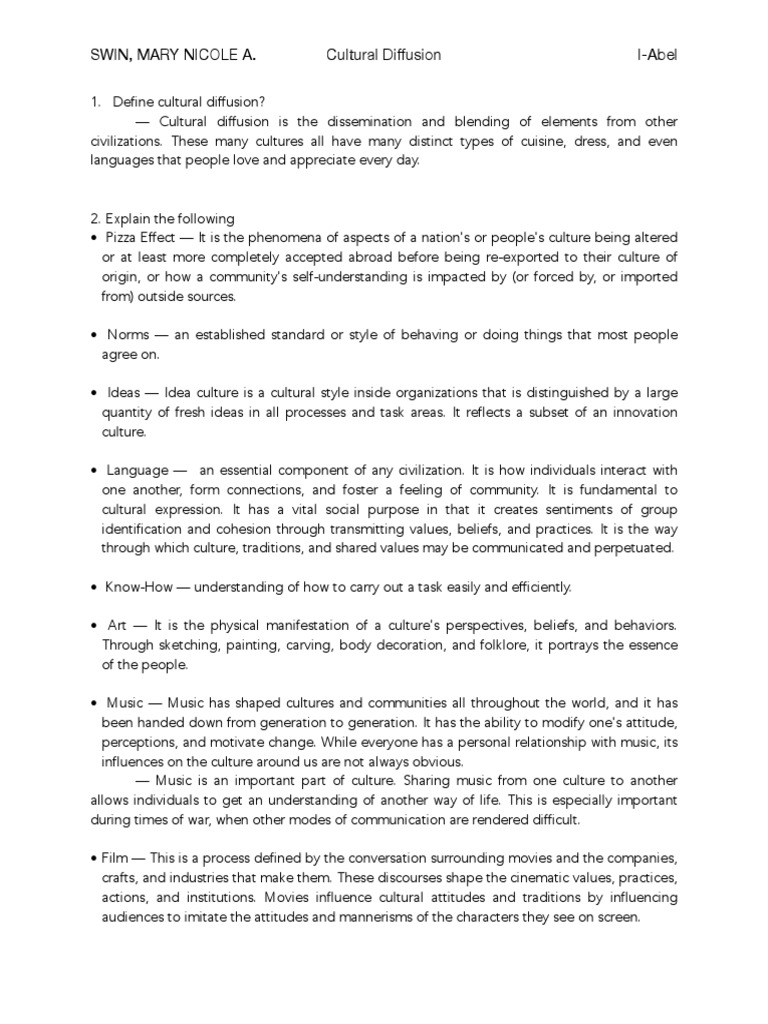Cultural diffusion is a pivotal concept within social studies, encapsulating the process through which cultural elements, including beliefs, practices, technologies, and artifacts, traverse from one society or group to another. This exchange may occur through various channels, manifesting in a range of forms and severing the insular boundaries of civilizations. The implications of cultural diffusion are manifold, shedding light on human interactions and how societies evolve over time.
At its core, cultural diffusion can be categorized into several distinctive types, each denoting a specific mechanism through which cultural elements are transmitted. The primary forms include direct diffusion, indirect diffusion, and stimulus diffusion, with each contributing uniquely to the tapestry of human culture.
Direct diffusion occurs when two distinct cultural groups come into direct contact with one another. This interaction is often precipitated by migration, trade, conquest, or colonization. For instance, the establishment of trade routes in ancient times, such as the Silk Road, facilitated the exchange of not just goods but also ideas and religious beliefs among diverse civilizations. The result was a significant transformation of cultural landscapes, as seen in the synthesis of art and philosophy beginning to flourish in exchanged societies.
Indirect diffusion, on the other hand, involves the transmission of cultural elements through an intervening culture. This often occurs when one culture adopts practices from a second culture, which had previously adopted them from a third. An illustrative example is the spread of technological innovations, where ideas originating in one region, such as the wheel in Mesopotamia, make their way to another culture, such as the Indus Valley civilization, through intermediaries. This layered approach to cultural diffusion exemplifies the complexity and interconnectivity of human societies.
Stimulus diffusion takes a more nuanced route, wherein a specific cultural trait from one society inspires similar innovations or adaptations in another, even if the original trait is not directly adopted. For instance, the introduction of fast food in various global contexts has led to localized adaptations, resulting in hybrid culinary offerings that blend traditional practices with the fast-food model. This phenomenon illustrates how influence can engender originality within a new cultural framework.
Understanding cultural diffusion broadens the scope of social studies, enriching discussions around globalization, social change, and cultural identity. Particularly in an age characterized by rapid communication and migration, the implications of cultural diffusion are more pronounced than ever. The impact of the internet cannot be overstated. It serves as a double-edged sword, perpetuating the dissemination of cultural practices while simultaneously threatening the integrity of local traditions.
Another essential aspect of cultural diffusion is its influence on societal norms, values, and behaviors. For example, the advent of social media has transformed interpersonal communication, fostering new social norms that can transcend geographical boundaries. Concepts such as individualism, which find varying degrees of acceptance across cultures, have been amplified through the global reach of digital platforms, affecting perceptions and practices even in traditionally communal societies.
Cultural diffusion also plays an integral role in the realm of arts and literature. Artistic styles and literary genres frequently traverse borders, adapting and evolving in novel ways. The introduction of jazz music, originally an American innovation, has inspired myriad forms across the globe, resulting in unique interpretations and blends, such as Afro-Cuban jazz. Such cross-pollination enriches artistic expression, demonstrating how cultural diffusion can foster creativity while simultaneously celebrating diversity.
Furthermore, morphological changes in language provide compelling evidence of cultural diffusion. Languages evolve as they borrow lexicon and syntax from one another, reflecting the dynamic interaction of different cultures. The English language, for instance, has assimilated a plethora of words from Latin, French, and even indigenous languages, leading to a rich and diverse linguistic tapestry. Such linguistic diffusion encapsulates not just words but also shared histories and the complexities inherent in social interactions.
However, cultural diffusion is not devoid of challenges. The potential for cultural appropriation arises when dominant cultures adopt elements from marginalized cultures without understanding or respecting their significance. This misappropriation often perpetuates historical inequalities, prompting critical examination of power dynamics. An awareness of these issues is essential for fostering responsible cultural exchange and ensuring the safeguarding of valuable cultural heritages.
As we navigate an increasingly interconnected world, the study of cultural diffusion in the context of social studies remains more relevant than ever. It encourages critical engagement with the intricate dynamics of global interactions while fostering an appreciation for the richness of cultural diversity. By exploring the origins and adaptations of cultural traits, students and scholars alike can develop a nuanced understanding of how societies negotiate identity and coherence in an era of swift and relentless change.
In conclusion, the multifaceted nature of cultural diffusion offers profound insights into the complexities of human society. Through its various forms and impacts, it reveals the interconnectedness of cultures and the role they play in shaping one another. Whether examining direct, indirect, or stimulus diffusion, the importance of understanding these mechanisms becomes increasingly imperative as our global landscape continues to evolve.
